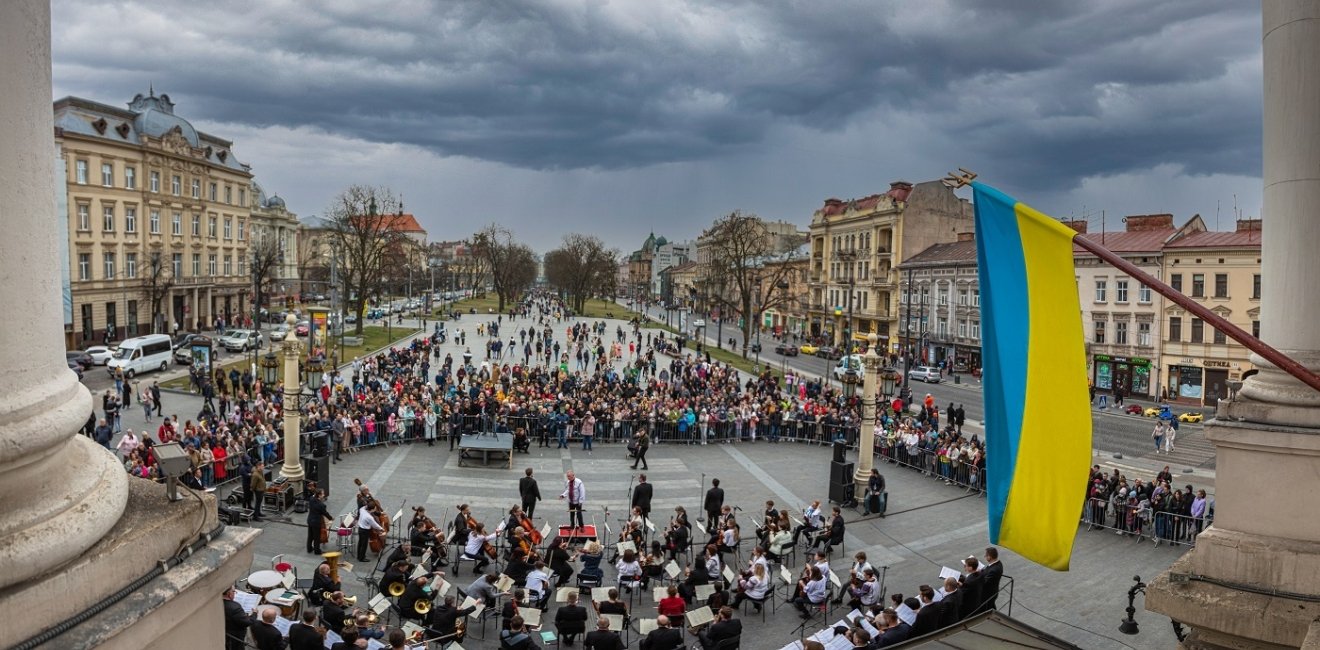
A blog of the Kennan Institute
BY BLAIR A. RUBLE
Just over a month after the war brought down the house lights inside the Lviv National Opera House, performances—both virtual and in person—have begun once again. As director Vasyl Vovkun told reporters from CNN, “We understand that light must defeat darkness, that life must defeat death, and the mission of the theater is to assert this.” Vovkun’s spirit reached beyond the theater to dancers and musicians scattered by the war. So many have found their way back to the theater to perform that Vovkun has been able to mount a program of ballets, operas, and concerts.
Many of the Opera’s artists and their neighbors in the western Ukrainian city of Lviv have been unable to avoid the horrors of today’s war even as the city has largely escaped Russian bombardment. Tens of thousands of Ukrainians displaced from the east have made their way to the city seeking haven. Air raid sirens regularly sound. City residents have gone off to fight, while many have relatives in the east who have been under savage attack. A night at the ballet would seem an impossible pleasure under such conditions. Vovkun and his company know better.
Lviv’s Opera House is a delightful marvel, a confection left over from the days when the city was ruled from Vienna. Hapsburg rulers may have been ghastly, but they had good taste. From Prague to Salzburg, Trento to Krakow, the Balkans nearly to the Black Sea, Hapsburgian provincial towns offered an abundance of cafés, coffee houses, pastries, picturesque town squares, tree-lined boulevards, and jewel-box opera houses no matter the local language, ethnicity, or confession.
Ukraine's Lviv is imbued with such Hapsburgian charm, and no place more so than in its captivating Opera House dominating the city's central square. As the turn of the twentieth century approached, the great and the good of Lviv (then known as Lemberg) came together to commission an opera house befitting the city’s role as the provincial capital of Galicia.
Designed by Berlin-trained Zygmunt Gorgolewski, the theater combined modern construction methods—it rests on a reinforced concrete foundation—with the traditional opulence of the era’s Neo-Baroque style. Columns, statues, reliefs, and frescos representing a mishmash of allegorical figures and heroic personages decorate every surface, giving the impression that one of the city’s outlandish pastries has come to life.
Opening night on October 4, 1900, was an event for the ages, attracting painters, writers, and composers from across the Austro-Hungarian Empire, including the writer Henryk Sienkiewicz, the composer Ignacy Jan Paderewski, and the painter Henryk Siemiradzki. Armenian Catholic archbishop Izaak Mikolaj Isakowicz, Rabbi Ezechiel Caro, and Protestant pastor Garfel blessed the theater on behalf of the city’s many cultural and religious communities.
Vovkun and his performers chose to relaunch the theater this month with a performance of Giselle, one of the oldest and most effervescent works in the ballet repertoire that still is performed today.
The story of a beautiful peasant girl wronged by a deceitful nobleman; the ballet has been a popular mainstay of ballet stages since its June 1841 premiere in Paris. Tweaked and reworked, modernized, rehabilitated, and revised, Giselle has managed to survive as a relic of artistic eras long past. Its multitudinous white tutus, leaping princes, and faux-peasant stage sets provide a perfect haven from war, especially when the ballet is performed in as sumptuous a venue as the Lviv Opera House.
War nonetheless intrudes on every aspect of life, even in a city that has avoided the horrendous destruction further to the east. Twenty-one-year-old Darnya Kirik, who danced the lead role, embraced the opportunity to perform as a release from the crushing emotions arising from the war. Her mother, grandmother, sister, and their pets only recently survived a horrific evacuation from once occupied Bucha. Knowing that her mother was now in Poland helped bring some peace. But such welcome news could not erase the terrors of war through which her family had lived.
Audiences at the ballet, and at subsequent performances and concerts, are limited to 300, the number that can be accommodated safely in the Opera’s bomb shelter. Air raid sirens interrupt applause, and once the curtain comes down the spectators return to families torn apart by war. Yet for two hours, a museum piece such as Giselle performed in the gilded hall of a long past epoch is a glorious antidote to the grotesqueries of the Russian invasion.
The opinions expressed in this article are those solely of the authors and do not reflect the views of the Kennan Institute.
Author

Former Wilson Center Vice President for Programs (2014-2017); Director of the Comparative Urban Studies Program/Urban Sustainability Laboratory (1992-2017); Director of the Kennan Institute for Advanced Russian Studies (1989-2012) and Director of the Program on Global Sustainability and Resilience (2012-2014)

Kennan Institute
After more than 50 years as a vital part of the Wilson Center legacy, the Kennan Institute has become an independent think tank. You can find the current website for the Kennan Institute at kennaninstitute.org. Please look for future announcements about partnership activities between the Wilson Center and the Kennan Institute at Wilson Center Press Room. The Kennan Institute is the premier US center for advanced research on Eurasia and the oldest and largest regional program at the Woodrow Wilson International Center for Scholars. The Kennan Institute is committed to improving American understanding of Russia, Ukraine, Central Asia, the South Caucasus, and the surrounding region through research and exchange. Read more

Explore More in Focus Ukraine
Browse Focus Ukraine
Talking to the Dead to Heal the Living

Ukrainian Issue in Polish Elections


